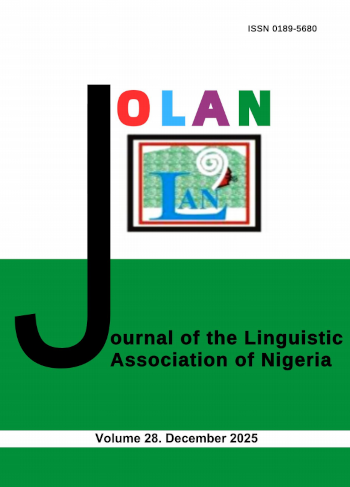A Linguistic Analysis of the Ígálâ Plural Markers, àma-/àbó-
Keywords:
Igala, morphological status, pro-inflectional affix analysis, plural markers, àma-/àbó-Abstract
The morphological status of the Igala plural markers is not clear based on varied accounts. One account claims they are inflectional/affixal elements while the other claims they are lexical elements. This paper is a pro-inflectional affix analysis of the Igala plural marker with linguistic evidence from the levels of phonology, morphology, semantics and syntax. Language samples for this paper come from the native speakers of Igala through direct personal contact in day-to-day social interactions, supplemented by the researcher’s intuition as a native speaker of the Dekina variety of Igala and archival evidence. The data are glossed morpheme-by-morpheme for analysis within a descriptive paradigm with no particular recurs to a specific theory. The plural morphemes are analyzed as VCV syllable structures in conformity with the typical syllable pattern of the language, with dialectal phonological variation responsible for the àbó-/àm ̀bó- interchange. The paper treats the plural morphemes as agglutinative affixes which mark plural inflection, the affixation of the morphemes being syntactically determined as typical of inflectional paradigms. The paper further establishes the plural markers as elements devoid of the semantic contents usually associated with homophonous nominal elements to the plural markers. The syntactic rule of relativization affects the combination of the plural markers and nouns in a manner characteristic of inflectional affix-stem rather than word-word relationship. This paper therefore establishes a linguistic analysis of the plural markers in Igala as inflectional elements and concludes that the Igala plural affixes are àma- and àbó-, which attach to noun stems for plural formation.
References
Akinkugbe, Femi. 1978. A comparative phonology of Yoruba dialect, Isekiri and Igala. PhD Dissertation. University of Ibadan.
Atadoga, F.T. 2011. Igala Morphology. In G.S. Omachonu (ed.). Igala language studies, 76 –102. Saarbrucken: Lambert Academic Publishing.
Capo, H.B.C. 1989. Defoid. In Bendor-Samuel. J. (ed.). The Niger Congo languages. Lanham and London: University Press of America, 275-290.
Chomsky, Noam. 1981. Lectures on Government and Binding. Dordrecht: Foris.
Crystal D. 1997. A dictionary of linguistics and phonetics. 4th Edn. Massachusetts: Blackwell Publishers.
Ejeba, S.O. 2012. A note on grammatical number in Igala. Kiabara, 3, 307 – 312.
____. 2016. A grammar of Igala. Port Harcourt: M&J Grand Orbit Communications.
Goldsmith, J.A. 1999. An overview of Autosegmental Phonology. In J.A. Goldsmith. (ed.). Phonological theory: Essential readings, 137 – 161. Massachusetts and Oxford: Blackwell Publishers.
Ilori, J.F. 2013. Plural devices in Igala. In W. Adegbite, A. Ogunsiji and O. Taiwo (eds.). Linguistics and glocalisation of African languages for sustainable development, 453 – 473. Ibadan: Universal Akada Books Limited.
Kari, E.E. 2015. Morphology: An introduction to the study of word structure. Choba: University of Port Harcourt Press Ltd.
Katamba, F. and J. Stonham. 2006. Morphology. 2nd Edn. New York: Palgrave Macmillan.
Luraghi, S. and C. Parodi. 2008. Key terms in syntax and syntactic theory. London: Continuum International Publishing Group.
Matthews, P. 1997. The concise Oxford dictionary of linguistics. Oxford: OUP
Omachonu, G.S. 2004. Animacy hierarchy: A case for noun plural formation in Igala language. In M.E. Attah, G.S. Omachonu, S.Y. Atabo, P.M. Onekutu and E.M.A. Adama (eds.). Language and literature in education for a better society: The challenges of the 21st century, 201 – 207. Nsukka: Great AP Express Publishers.
___. 2008. Inflectional morphology in Igala. JOLAN, 11, 33 – 40.
___. 2011. Phonetics and phonology. In G.S. Omachonu (ed.). Igala language studies, 46 – 75. Saarbrucken: Lambert Academic Publishing.
Sadock, J.M. and A.M. Zwicky.1985. Speech act distinction in syntax. In T. Shopen (ed.). Language typology and syntactic description, Vol. I, 156 – 196. Cambridge: CUP














